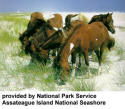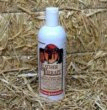
- Chincoteague - |
|||
|
The Assateague and the
Chincoteague are basically the same pony, found mainly on
the Island of The tale of the Chincoteague pony is of the horses swimming to Assateague Island from a shipwrecked Spanish galleon. However, the more plausible explanation is that they descended from horses that were brought to Assateague during the 17th century by mainland owners in order to avoid fencing laws and livestock taxes. Today the horses are actually the size of ponies, most likely due to their poor diet and harsh living environment. Some of them, removed from Assateague as foals and fed a high protein diet, grow to horse size. On the islands, however, 80 percent of their diet is coarse saltmarsh cordgrass, and American beachgrass. They also eat various types of grass, bayberry twigs, rose hips, seaweed, and poison ivy. The high salt concentration in their diets causes them to drink almost twice as much fresh water as domesticated horses. This is why they tend to have a bloated appearance. Despite the abundance of salt water around them, they very rarely drink it. The ponies are split into two main herds, one of the Virginia end of the island and the other on the Maryland end. There is a fence on the state line that separates the herds. The population is controlled, keeping around 150 ponies in order to lessen their impact on the island's ecology. The herds have divided themselves into bands of two to twelve ponies. Each herd occupies a home range. The National Park Service owns and manages the Maryland herds, while the Chincoteague Volunteer Fire Department owns and manages the Virginia herds. The herds are kept to about 150 animals in order to protect the existence of other natural resources in the wildlife refuge. The Virginia herd is the herd commonly known as the "Chincoteague" pony, due to the fact that they graze on land owned by the Chincoteague Wildlife Reserve. Horse management programs have been instituted, even going so far as to give the horses shots that prevent pregnancy by increasing the amount of antibodies in the horse's immune system. The annual Pony Penning Day is a big thing that attracts people to Assateague Island to see the Chincoteague ponies swim across the channel. What an awesome site....young and old alike forging the channel to solid ground.
Jasper Stable Blanket Equine Hoof Moisturizer Leather Therapy Restorer
|
|||
|







